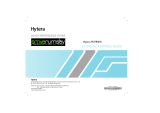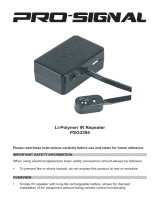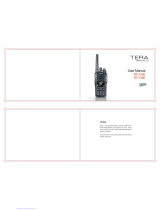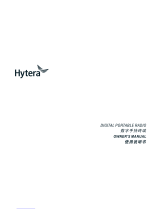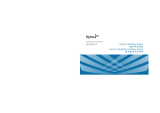Page is loading ...

TP9300
DMR Portable Radios
User’s Guide
MPD-00001-08 · Issue 8 · August 2017


Contents 3
Contents
For your safety..................................................................9
Menu maps......................................................................28
1 About this guide ............................................................30
Safety warnings used in this guide........................................... 30
Related documentation............................................................. 31
2 Before using your radio ................................................32
For your safety — battery warning............................................. 33
Attaching labels to the radio or battery ..................................... 33
Charging the battery before first use ........................................ 34
Attaching the battery................................................................. 35
Removing the battery ............................................................... 35
Attaching the antenna............................................................... 36
Removing the antenna ............................................................. 36
Attaching a belt clip .................................................................. 36
Removing a belt clip ................................................................. 36
Installing an audio accessory ................................................... 37
3 Getting started ...............................................................38
About your DMR digital radio.................................................... 39
About the radio controls............................................................ 41
Understanding the radio display ............................................... 43
Understanding the radio indicators........................................... 45
Using function keys to access frequently used features........... 48
Navigating the radio’s menus ................................................... 49
Using the alphanumeric keys to search a list ........................... 50
4 Basic operation ..............................................................51
Turning the radio on and off ..................................................... 52
Adjusting the speaker volume .................................................. 53
Locking and unlocking the keypad ........................................... 53
Using a wireless headset.......................................................... 54
Changing the radio’s operating mode....................................... 59
Setting and viewing the radio’s time and date.......................... 60
5 Using the address book ................................................61
Opening the address book ....................................................... 62
Changing the default address book.......................................... 62
Navigating the address book .................................................... 63
Filtering address book lists ....................................................... 64
Maintaining personal address book entries .............................. 65
6 Operating in conventional mode ..................................69

4 Contents
Selecting a zone ....................................................................... 70
Selecting a channel .................................................................. 71
Selecting a scan or voting group .............................................. 72
Understanding talkgroups......................................................... 74
Making a call............................................................................. 75
Making an individual call........................................................... 77
Making a preset call.................................................................. 77
Making a call using the address book ...................................... 77
Making a local call .................................................................... 78
Dialing a radio call .................................................................... 79
Making a phone call.................................................................. 80
Making a DTMF patch call........................................................ 80
Making an emergency call........................................................ 82
Setting your status (on analog channels) ................................. 83
Sending and receiving status messages.................................. 83
Sending and receiving text messages...................................... 85
Checking the queue.................................................................. 89
Call alert ................................................................................... 90
Radio check.............................................................................. 91
Radio monitor ........................................................................... 92
Radio inhibit and uninhibit ........................................................ 94
Resending calls automatically .................................................. 96
Transmitting at low power......................................................... 97
Ending active calls.................................................................... 98
Using monitor and squelch override (on analog channels) ...... 99
Bypassing the repeater (on analog channels)........................ 100
Receiving a call ...................................................................... 101
Using the radio in different repeater areas ............................. 101
Scanning a group of channels................................................ 102
7 Operating in trunked mode .........................................108
Checking that your network is available ................................. 109
Changing your network........................................................... 109
Making a call using the address book .................................... 110
Making a preset call................................................................ 111
About trunked zones and workgroups .................................... 112
About emergency operation ................................................... 116
Dialing a PABX number.......................................................... 118
Dialing a PSTN number.......................................................... 118
Receiving a call ...................................................................... 119
Re-establishing a call ............................................................. 121
Checking the queue................................................................ 122
About status messages .......................................................... 124
About trunked text messages ................................................. 126
Placing the radio in do-not-disturb mode................................ 129
Switching to conventional channels or conventional groups .. 130

Contents 5
8 Dialing calls in trunked mode .....................................131
MPT 1343 dialing.................................................................... 132
DMR dialing ............................................................................ 134
Nokia ANN fleet calls.............................................................. 136
Accessing common trunking functions ................................... 138
9 Location services ........................................................140
About location information ...................................................... 141
About location statuses .......................................................... 141
Viewing location information................................................... 142
10 Loneworker monitoring ..............................................144
Activating loneworker monitoring............................................ 145
Responding to a loneworker alarm......................................... 145
11 Encryption ....................................................................147
About encryption..................................................................... 148
Encrypting calls ...................................................................... 148
Making an encrypted call........................................................ 149
Receiving an encrypted call.................................................... 149
Removing encryption keys from the radio .............................. 150
12 Customizing radio settings ........................................151
Changing the volume of all audible indicators ........................ 152
Changing the volume of keypress tones ................................ 152
Changing to quiet operation ................................................... 153
Changing to silent operation................................................... 153
Turning on backlighting .......................................................... 154
Adjusting the display contrast................................................. 155
13 Charging and caring for batteries ..............................156
About the chargers ................................................................. 157
6-way charger safety information ........................................... 158
Special conditions when using IS/NI radios............................ 158
Before using the charger ........................................................ 159
Charging temperatures........................................................... 160
Leaving the battery on charge ................................................ 160
Receiving calls while charging (not for battery-only vehicle
charger) .................................................................................. 161
Low battery warning ............................................................... 162
Inserting the radio into the vehicle charger............................. 163
Charging a battery for the first time ........................................ 164
Charging a battery .................................................................. 164
LED behavior.......................................................................... 165
Removing the battery from the charger .................................. 166
Maintaining battery life and performance ............................... 166
Storing batteries ..................................................................... 167

6 Contents
Disposing of batteries ............................................................. 167
14 Troubleshooting ..........................................................168
About troubleshooting............................................................. 169
When your radio won’t turn on................................................ 169
Identifying the radio’s audible tones ....................................... 169
Viewing radio information ....................................................... 170
General care........................................................................... 170
Directive 1999/5/CE Declaration of Conformity .........172
Tait Software Licence Agreement...............................173

7
Copyright and trademarks
All information contained in this document is the property of
Tait Limited. All rights reserved. This document may not, in
whole or in part, be copied, photocopied, reproduced,
translated, stored, or reduced to any electronic medium or
machine-readable form, without prior written permission from
Tait Limited.
The word TAIT and the TAIT logo are trademarks of Tait
Limited.
All trade names referenced are the service mark, trademark
or registered trademark of the respective manufacturers.
Disclaimer
There are no warranties extended or granted by this
document. Tait Limited accepts no responsibility for damage
arising from use of the information contained in the document
or of the equipment and software it describes. It is the
responsibility of the user to ensure that use of such
information, equipment and software complies with the laws,
rules and regulations of the applicable jurisdictions.
Enquiries and comments
If you have any enquiries regarding this document, or any
comments, suggestions and notifications of errors, please
contact your regional Tait office.
Updates of manual and equipment
In the interests of improving the performance, reliability or
servicing of the equipment, Tait Limited reserves the right to
update the equipment or this document or both without
prior notice.
Intellectual property rights
This product may be protected by one or more patents or
designs of Tait Limited together with their international
equivalents, pending patent or design applications, and
registered trade marks: NZ 409837, NZ 409838, NZ 415277,
NZ 415278, NZ 530819, NZ 534475, NZ 547713, NZ 577009,
NZ 579051, NZ 579364, NZ 586889, NZ 610563, NZ 615954,
NZ 700387, NZ 708662, NZ 710766, NZ 711325 , NZ 726313,
NZ593887, AU 2015215962, AU 339127, AU 339391,
AU2016259281, AU2016902579, EU 000915475-0001,
EU 000915475-0002, GB 2532863, US 14/834609 Div. no 1,
US 15/346518 Div.no 2, US 15/350332, US 15/387026 Div.,
US 20150085799, US 20160044572, US 20160057051,

8
US 640974, US 640977, US 698339, US 702666, US 7758996,
US 8902804, US 9107231, US 9504034, US 9559967.
This product may also be made under license under one or
more of the following patents:
- US7203207, AU2004246135, CA2527142, GB2418107,
HK1082608, MY134526, US8306071
- US7339917, AU2004246136, CA2526926, GB2418812,
MY134217
- US7499441, AU2005262626, CA2570441, GB2430333,
JP4690397, NZ551231, KR100869043, RU2351080,
BRP10512052, MXPA06015241
- US 7200129, AU2005226531, CA2558551, CN1930809,
GB2429378, JP4351720, BRP10508671, NZ549124,
KR848483, RU2321952
The AMBE+2™ voice coding Technology embodied in this
product is protected by intellectual property rights including
patent rights, copyrights and trade secrets of Digital Voice
Systems, Inc. This voice coding Technology is licensed solely
for use within this Communications Equipment. The user of
this Technology is explicitly prohibited from attempting to
decompile, reverse engineer, or disassemble the Object
Code, or in any other way convert the Object Code into a
human-readable form.
The Bluetooth® word mark and logos are registered
trademarks owned by Bluetooth SIG, Inc, and any use of
such marks by Tait Limited is under licence. Other
trademarks and trade names are those of their respective
owners.
Environmental responsibilities
Tait Limited is an environmentally responsible company
which supports waste minimization, material recovery and
restrictions in the use of hazardous materials.
The European Union’s Waste Electrical and Electronic
Equipment (WEEE) Directive requires that this product be
disposed of separately from the general waste stream when
its service life is over. For more information about how to
dispose of your unwanted Tait product, visit the Tait WEEE
website at
www.taitradio.com/weee
. Please be
environmentally responsible and dispose through the original
supplier, or contact Tait Limited.
Tait Limited also complies with the Restriction of the Use of
Certain Hazardous Substances in Electrical and Electronic
Equipment (RoHS) Directive in the European Union.
In China, we comply with the Measures for Administration of
the Pollution Control of Electronic Information Products. We
will comply with environmental requirements in other markets
as they are introduced.

For your safety 9
For your safety
Before using your radio, please read the following
important safety and compliance information.
Intrinsically Safe and Non-Incendive
radios and accessories
Intrinsically Safe (IS) and Non-Incendive (NI) radios and
accessories are certified by a third party to be safe to use
in particular hazardous locations, or in potentially
explosive atmospheres.
Warning Explosion hazard!
IS/NI certification applies
only while the product is used in accordance with these
instructions.
Warning Explosion hazard!
Ensure that the ratings
printed on a label on the equipment will permit your IS/NI
radio and accessories to be used in your hazardous
location. Refer also to
"Rating matching" on page 14
.
Warning Explosion hazard!
Use only a Tait-supplied,
IS/NI-approved battery, charger, antenna, audio
accessory, carry accessory or programming adapter with
an IS/NI radio. Fitting a battery or accessory that is not IS/
NI-approved, using a charger that is not IS/NI-approved,
or failing to use the IS/NI programming adapter, creates a
risk of explosion which could cause serious injury or
death. For an up-to-date list of approved accessories,
contact your regional Tait office.
Warning Explosion hazard!
Do not charge the
battery, or change the antenna, in a hazardous location.
An explosion could cause serious injury or death.
Warning Explosion hazard!
You must use a battery
carry case when carrying a spare battery into a hazardous
area.

10 For your safety
IS/NI radios, batteries, antennas and accessories must
not be engraved or modified in any way. Do not use the
radio, battery or accessory if it is cracked or damaged. Do
not use the antenna if the sheathing is split or the end cap
is missing. Do not expose the radio to solvents. IS/NI
radios and accessories must be serviced only by an
agency certified by both the approval authority and by Tait
Limited. Any unauthorized repair or substitution of parts
invalidates the IS/NI rating and the third party IS/NI
approval. To have an IS/NI radio serviced, return it to your
regional Tait office.
Radios
One or more of the following marks identifies a TP9300/
TP9400 radio as an IS/NI radio:
■
an IS circle logo on the radio’s front panel
■
a label on the radio, showing IS/NI information
■
a label on the radio battery, showing IS/NI information
Radios with the product code “T03-22xxx-xxxx” have IS/
NI approval and are approved to one or several of the
following ratings. Refer also to
"Rating matching" on
page 14
.
■
Class I, Zone 1, AEx ib IIC T4...T3 (USA)
■
Class I, Zone 1, AEx ib IIA T4...T3 (USA)
■
Class I, Division 2, Group A, B, C, D, T4...T3
(USA and Canada)
■
Class II, Division 2, Group E, F, G T4...T3
(USA and Canada)
■
Class III, Division 1 (USA and Canada)
■
Ex ib IIC T4...T3 Gb (Canada)
■
Ex ib IIA T4...T3 Gb (Canada)

For your safety 11
■
II 2 G Ex ib IIC T4...T3 Gb (ATEX)
■
II 2 G Ex ib IIA T4...T3 Gb (ATEX)
■
Ex ib IIC T4...T3 Gb (IECEx)
■
Ex ib IIA T4...T3 Gb (IECEx)
T4: –20°C
≤
Ta
≤
+50 °C
T3: –20°C
≤
Ta
≤
+60 °C
Batteries
The following batteries have been approved for use with
TP9300/ TP9400 IS/NI portable radios.
Refer also to
"Rating matching" on page 14
.
Chargers
Chargers are common to IS and NI batteries. The
chargers for IS/NI batteries are marked with an IS circle
logo and have the following product code:
■
T03-22011-xAxx (AEx and Canada)
■
T03-22011-xDxx (IECEx and EU)
You must use these chargers with an IS/NI battery, as
their internal circuitry provides additional protection for the
IS circuitry in the battery and radio.
Warning Explosion hazard!
Do not use the charger in
a hazardous location. An explosion could cause serious
injury or death.
Description Product code
Li-Ion, 2300 mAh, AEx-USA, IIA T03-22001-AAAA
Li-Ion, 2300 mAh, AEx-USA, IIC T03-22001-AACA
Li-Ion, 2300 mAh, ATEX, IIA T03-22001-ABAA
Li-Ion, 2300 mAh, ATEX, IIC T03-22001-ABCA
Li-Ion, 2300 mAh, IECEx, IIA T03-22001-ADAA
Li-Ion, 2300 mAh, IECEx, IIC T03-22001-ADCA
Li-Ion, 2300 mAh, Ex-Canada, IIA T03-22001-AEAA
Li-Ion, 2300 mAh, Ex-Canada, IIC T03-22001-AECA

12 For your safety
Notice
The IS/NI battery can only be charged in the
chargers listed above. It will not charge in other TP8100/
TP9300/TP9400 chargers. However, the chargers listed
above can charge non-IS TP8100/TP9300/TP9400
batteries.
The operating temperature range for the charger is +32 °F
to +104 °F (0 °C to +40 °C).
Audio accessories
One or more of the following marks identifies a TP9300/
TP9400 audio accessory as an IS/NI audio accessory:
■
an IS circle logo on the audio accessory
■
a label on the audio accessory, showing IS/NI infor-
mation
The following audio accessories have been approved for
use with TP9300/ TP9400 IS/NI portable radios.
Refer
also to
"Rating matching" on page 14
.
Carry cases
IS/NI leather carry cases are marked with an IS circle logo
. The following carry cases have been approved for use
with TP9300/TP9400 IS/NI portable radios.
Description Product code
Headset, Heavy Duty, over-the-head T03-22008-BAAA
Headset, Heavy Duty, behind-the-head T03-22008-BABA
Earphone, in-ear, 2.5 mm jack T03-22008-CAAA
Speaker microphone, Storm, IP68-rated,
emergency button, High/Low volume button,
2.5 mm jack
T03-22008-AAAA
Description Product code
Carry case, heavy-duty, leather, belt loop with
D-stud
T03-22007-0001
Carry case, heavy-duty, leather, spring clip T03-22007-0002
Carry case, heavy-duty, leather, belt loop T03-22007-0003
1
Battery carry case, heavy-duty, leather T03-22007-0004
Battery carry case, heavy-duty, leather, belt
loop with D-stud
T03-22007-0005

For your safety 13
Carry accessories are not specifically rated, and may be
used in any area, subject to the rating restrictions of the
overall radio system.
Warning Explosion hazard!
You must use a battery
carry case when carrying a spare battery into a hazardous
area.
Antenna
Use only genuine Tait-supplied antennas. Antennas are
not specifically rated and may be used in any area,
subject to the rating restrictions of the overall radio
system.
Programming adapter
The IS programming adapter is marked with an IS circle
logo and has the product code:
■
T03-22009-AAAA (AEx and Canada)
■
T03-22009-ADAA (IECEx and EU)
Warning Explosion hazard!
Do not use the IS
programming adapter in a hazardous location.
You must use the IS programming adapter with an IS/NI
radio, as its internal circuitry provides additional protection
for the IS/NI circuitry in the radio. All programming
activities are permitted. Calibration activities are only
permitted if the activity can be done with the programming
adapter alone. Other connections (e.g. antenna port) are
not permitted.
Battery carry case, heavy-duty, leather,
spring clip
T03-22007-0006
Battery carry case, heavy-duty, leather, belt
loop
T03-22007-0007
Belt loop for D-stud, 55 mm T03-00038-0022
Spring clip for D-stud, 40 mm T03-00038-0023
Belt clip, 55 mm TPA-CA-201
Belt clip adaptor for 55 mm belt clip TPA-CA-208
1. Must not be used with H7 band radios with whip antenna (TPA-AN-012).
Description Product code

14 For your safety
Equipment repair
Warning Explosion hazard!
IS/NI radios and
accessories are not user-serviceable. IS and NI radios
and accessories must be serviced only by an agency
certified by both the approval authority and by Tait Limited.
Any unauthorized repair or substitution of parts invalidates
the intrinsic safety or non-incendive rating and the third
party IS or NI approval. To have an IS and NI radio
serviced, return it to your regional Tait office.
Rating matching
The rating of the radio, battery and accessories must be
reviewed to ensure a safe IS/NI radio system. IS/NI
ratings must be “matched”, and the lowest approval level
determines the overall IS/NI radio system approval.
Equipment labels clearly identify the item’s ratings.
Zone ratings
■
Use only Gas Group IIC batteries with Gas Group IIC
radios.
Use only Gas Group IIA batteries with Gas Group IIA
radios.
■
Gas Group IIC rated accessories may be used with
IIA radios, but the combination may only be used in a
IIA Gas atmosphere.
■
Gas Group IIC and Dust Group IIIC rated accessories
may be used with Gas Group IIC or IIA radios, but the
combination may only be used in a gas atmosphere.
■
Gas Group IIC rated radios and accessories may be
used in Gas Group IIB or IIA areas.
■
Zone 1 rated radios and accessories may be used in
Zone 2 areas.
■
Any item approved to Gas Group IIA will limit the
radio system to a Gas Group IIA area. For use in a
Gas Group IIC area, all items must be approved to
Gas Group IIC.

For your safety 15
Division ratings
■
Use only Group D battery with Group D radios.
Use only Group A, B, C, D battery with Group A, B, C, D
radios.
■
Gas Class I and Dust Class II and Class III rated
accessories may be used with Gas Class I radios, but
the combination may only be used in a Gas Class I
hazardous (classified) location.
■
Division 2 rated radios and accessories may only be
used in Division 2 or Zone 2 hazardous (classified)
locations.
■
Division 2, Group A radios and accessories may be
used in Division 2, Group B, C, or D areas.
■
Any item approved to Group D will limit the radio sys-
tem to Group D areas. For use in a Group A area, all
items must be approved to Group A.
Temperature class
Different ambient temperature ranges apply for the T3
and T4 temperature classes. The item with the most
restrictive temperature range will determine the allowed
temperature range of the radio system. T4-rated radios
and accessories can be used in T3 areas, within the rules
stated above.

16 For your safety
Entity parameters
The Entity Concept allows interconnection of IS/NI
equipment with associated equipment when the following
is true:
Ui
≥
Uo, Ii
≥
Io, Pi
≥
Po, Ci
≤
Co, Li
≤
Lo, and Li/Ri
≤
Lo/Ro.
The installation must be in accordance with the following
standards:
■
National Electrical Code (NEC), ANSI/NFPA 70, Arti-
cles 504 and 505
■
Canadian Electrical Code (CEC) Part I, CAS C22.1
■
ANSI/ISA-RP12.06.01
■
EN/IEC 60079-25
■
relevant local regulations.
TP9300/TP9400 IS/NI radios have the following entity
parameters.
Radio accessory port:
Radio battery port:
■
Uo 7.2 V
■
Io 0.42 A
■
Po 1.3 W
■
Co 1.97
μ
F
■
Lo 100
μ
H
■
Lo/Ro 20
μ
H/
Ω
■
Ui 8.4 V
■
Ii IIA: 2.9 A
IIC: 1.9 A
■
Um 9.0 V (charging)
■
Ci 1.2
μ
F
■
Li 5.7
μ
H

For your safety 17
Battery:
Ambient pollution degree: 4
Overvoltage category: I
Certificates
Standards
Charging Terminals
■
Um 9.0 V
Battery Output (radio port)
■
Uo 8.4 V
■
Io IIA: 2.9 A
IIC: 1.9 A
■
Co 1.2
μ
F
■
Lo 5.7
μ
H
Radio: Battery:
■
MET E113958
■
TÜV 15 ATEX 7792X
■
TÜV 15 ATEX 7791X
■
IECEx ITA 15.0015X
■
IECEx ITA 15.0009X
■
ANSI/ISA-12.12.01-2015
■
CAN/CSA-C22.2 No. 213-15
■
ANSI/UL 60079-0
■
ANSI/UL 60079-11
■
CAN/CSA-C22.2 No. 60079-11:14
■
CAN/CSA-C22.2 No. 60079-0:15
■
EN 60079-0:2012/A11:2013
■
EN 60079-11:2012
■
IEC 60079-0:2011 6th edition
■
IEC 60079-11:2011 6th edition

18 For your safety
Radio frequency exposure information
For your own safety and to ensure you comply with the
radio frequency (RF) exposure guidelines of the United
States Federal Communication Commission’s (FCC),
Industry Canada, and those from other administrations,
please read the following information before using this
radio.
Using this radio
You should use this radio only for work-related purposes
(it is not authorized for any other use) and if you are fully
aware of, and can exercise control over, your exposure to
RF energy. To prevent exceeding FCC RF exposure
limits, you must control the amount and duration of RF
that you and other people are exposed to.
It is also important that you:
■
Do not remove the RF Exposure label from the radio.
■
Ensure this RF exposure information accompanies
the radio when it is transferred to other users.
■
Do not use the radio if you do not adhere to the guide-
lines on controlling your exposure to RF.
Controlling your exposure to RF energy
This radio emits radio frequency (RF) energy or radio
waves primarily when calls are made. RF is a form of
electromagnetic energy (as is sunlight), and there are
recommended levels of maximum RF exposure.
To control your exposure to RF and comply with the
maximum exposure limits for occupational/controlled
environments, follow these guidelines:
■
Do not talk (transmit) on the radio more than the rated
transmit duty cycle. This is important because the
radio radiates more energy when it is transmitting
than when it is receiving.
■
When listening and talking on the radio, hold it upright
in front of your face so that it is at least one inch
(2.5 cm) away from any part of your face. Keeping the
radio at the recommended distance is important

For your safety 19
because exposure to RF decreases rapidly the further
away the antenna is from your body.
■
Keep the antenna at least one inch (2.5 cm) from your
face at all times.
■
If you wear your radio, you must always put it in a car-
rying accessory that has been specifically approved
by Tait for this radio. Using non-approved body-worn
accessories may mean you expose yourself to higher
levels of RF than recommended by the FCC’s occu-
pational/controlled environment RF exposure limits.
■
Ensure you only use Tait-approved antennas, batter-
ies, and accessories.
For more information on what RF energy is and how to
control your exposure to it, visit the FCC website at
www.fcc.gov/oet/rfsafety/rf-faqs.html
.
Compliance with RF energy exposure standards
This two-way radio complies with these RF energy
exposure standards and guidelines:
■
United States Federal Communications Commission,
Code of Federal Regulations; 47 CFR §§ 1.1307,
1.1310, and 2.1093.
■
American National Standards Institute (ANSI) / Insti-
tute of Electrical and Electronic Engineers
(IEEE) C95.1-1992.
■
Institute of Electrical and Electronic Engineers (IEEE)
C95.1-1999 Edition.
■
European Directive 2004/40/EC on minimum health
and safety requirements regarding the exposure of
workers to the risks arising from physical agents
(electromagnetic fields).
This radio complies with the IEEE and ICNIRP exposure
limits for occupational/controlled RF exposure
environments at operating duty factors of up to 50% talk
to 50% listen.

20 For your safety
Conformité aux normes d’exposition à l’énergie
RF
Cette radio émetteur-récepteur se conforme aux normes
et aux règlements d’exposition à l’énergie RF :
■
La Commission fédérale de la communication des
Etats-Unis, Code de règlements fédéraux (CFR) Titre
47 Sections 1.1307, 1.1310 et 2.1091 (radios mobi-
les) ou 2.1093 (radios portatives).
■
American National Standards Institute (ANSI) / Insti-
tute of Electrical and Electronic Engineers (IEEE)
C95. 1-1992.
■
Institute of Electrical and Electronic Engineers (IEEE)
C95.1-1999 Edition.
■
La directive européenne 2004/40/EC concernant les
prescriptions minimales de sécurité et de santé relati-
ves à l'exposition des travailleurs aux risques dus aux
agents physiques (champs électromagnétiques).
Cette radio se conforme aux limites d’exposition de l’IEEE
(FCC) et ICNIRP pour les environnements d’exposition
au rayonnement RF professionnel et contrôlé aux cycles
de marche de 50% en mode transmission et 50% en
mode réception.
Radio frequency emissions limits in
the USA
CFR Title 47 Part 15.19 (a) (1) - Receivers
Part 15 of the FCC Rules imposes RF emission limits on
receivers. This radio complies with Part 15 of the FCC
Rules. Operation is subject to the condition that this
device does not cause harmful interference.
CFR Title 47 Part 15.19 (a) (3) - All other devices
This device complies with Part 15 of the FCC Rules.
Operation is subject to the following two conditions.
(1) This device may not cause harmful interference, and
(2) This device must accept any interference received,
including interference that may cause undesired
operation.
/
